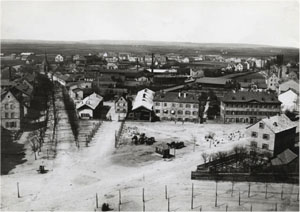1. The Plärrer in Nuremberg 1865 and 1905 as example for urban development
Questions
Geographical/Historical Context
The pictures of the Plärrer in Nuremberg of 1865 and 1905 show the distinct changes in the cityscape in the course of industrialization and urbanization.
Due to population growth in the cities, which was fostered by better health care and a decline of child mortality, the urban centres grew bigger and bigger and had to adjust to the new situation. Many people moved from the countryside to the cities. The population no longer lived on agriculture, but on industry.
The whole infrastructure of the city had to be adjusted to the new conditions. Among many factories which served as places of work for the workers, the provision of the population with basic supplies like electricity and water had to be ensured. The green areas within the city were further expanded, freely accessible gardens and parks emerged, a transport system with cable cars, pavements and a railway station provided for the mobility of the urban population.
The life of the population was to become as comfortable as possible even within the city. Cultural facilities like churches, theatres, cafés and libraries began to emerge in the new cityscape.
Answer to the Questions
1:
- Infrastructure: construction of traffic routes for public transport, trams, pavements for the passers-by
- City size: enlargement of the residential zone
- Architecture: construction of multi-storey houses, enlargement of the already existent buildings resp. demolition, new construction of a church, factories, green areas within the city, street lights (electricity), fountains.
2: Reasons: industrialization, urbanization, population growth.
3: New construction of big tenements with as many flats as possible, extension of the infrastructure (gas plant, streets lighting).






Presentation
The panoramic photographs of the Plärrer in Nuremberg of 1865 and 1905 show the distinct changes in the cityscape and the infrastructure (in Nuremberg, the Plärrer was a place for the fair in the 19th century and since 1835 the initial location of the Ludwig train station. Today, it is the traffic hub of the city).